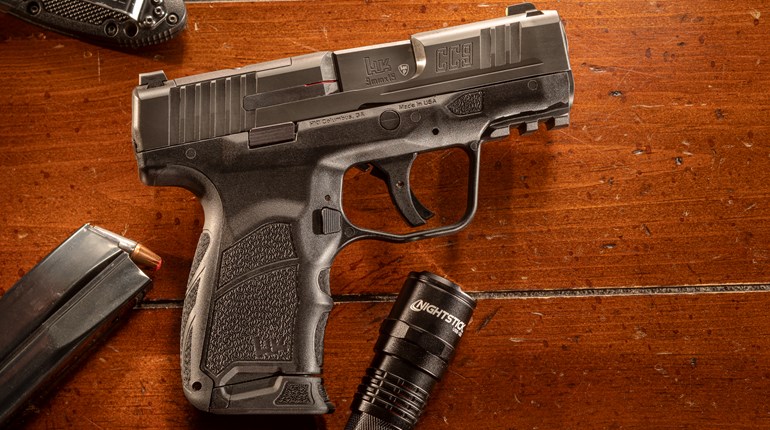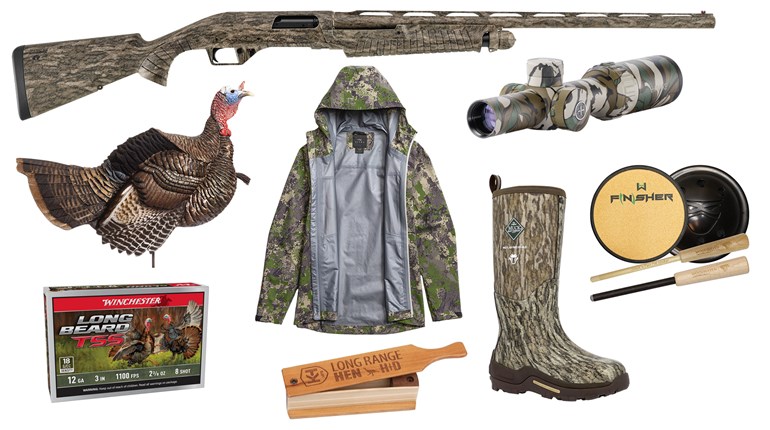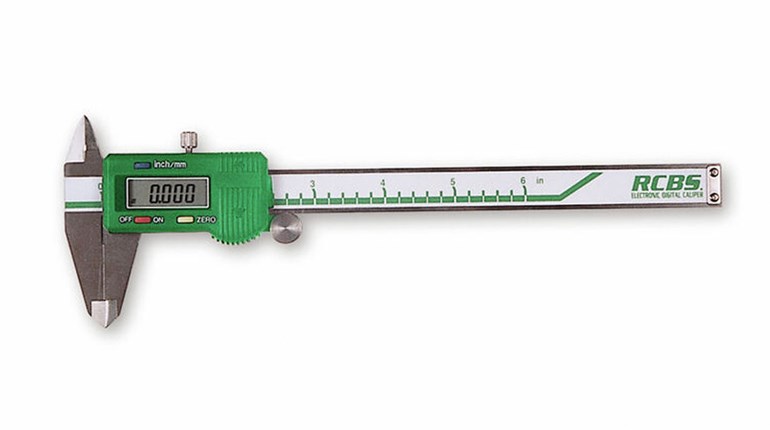
When manufacturers figured out how to fit a firearm into the niche in regulations that allowed for a smoothbore firearm that wasn’t a short-barreled shotgun (SBS), the shock (if you’ll pardon the pun) was immense. But, with the exception of the Mossberg 590M Shockwave, the end result was a tube-fed smoothbore, with the magazine underneath the barrel.
Armscor has added a contender to that world with a new, box-magazine-fed model. The VRF14 is a 12-gauge, smoothbore firearm that is not classified as an SBS. The basic layout looks very AR-15-ish, but it isn’t an AR-15. Instead of trying to wrestle a 12-gauge shell into an AR-15 (which would be a grand failure) or settle for a smaller-gauge chambering, Armscor designed the VRF14 around the 12-gauge round, and scaled the rest of the firearm accordingly. The company also made other changes to accommodate the regulatory requirements for this kind of firearm.

Controls are as you’d expect: a pistol grip at the rear (with some receiver still behind it, to accommodate the recoil system) and a selector/safety and magazine release. The selector is not ambidextrous, so left-handed shooters will just have to adapt. On the left side, you’ll find the bolt hold-open, which when you want to close the bolt, you simply press, as you would with an AR-15. The lower is aluminum, and at the rear there is a sling loop. You can rig a sling to carry the VRF14 in much the same way that the SAS used their MP5 submachine guns, with the sling around your neck and one arm through it. With the sling set to the correct length, you simply push the VRF14 out in front of you until the sling stops movement, align the sights or red-dot optic and fire. But, that’s getting a bit ahead of ourselves. The magazines are steel, and they push up into the magazine well in the same way as an AR-15. No “rock and lock” here, like magazines for the AK/M1A/M14/FAL. The magazines that came with the VRF14 held five rounds each, and the feed lips may appear to be short, even too short, but they worked perfectly. The VRF14 is also compatible with the Armscor VR-series magazines, and so you can also have nine- or 19-round mags to feed your VRF14, if you wish. The magazines lock the action open after the last round has been fired.
The upper half of the VRF14 is where the action happens. The model designation tells you the barrel length: 14 inches. The barrel does not have screw-in chokes fitted, but the performance of modern buckshot loads is much-improved over those of the old days, and in this case, choke is probably not needed. In pre-buffered buckshot days, we expected about an inch of pattern spread per yard of distance. So, at 10 yards, a 10-inch pattern was the “good old days” norm. With the VRF14 and modern buckshot loads, I found patterns were almost always less than 4 in diameter, with some smaller than 3. At 10 yards, the wad still had enough velocity to penetrate the target backer.
The barrel is shrouded inside the polymer shell that is the handguard. The handguard has a top rail that fits flush with the rail on top of the upper receiver. The receiver rail is only at the rear of the receiver, and only long enough to mount the rear sight of the folding sights that come with the VRF14, so if you mount an unmagnified red-dot optic (you should; it will be a blast) you will be bolting it to the rail that is part of the handguard. In disassembly and reassembly, the point-of-aim/point-of-impact did not change much, if at all, despite the optic and the barrel being separated and reassembled. In addition to the full-length top rail, the handguard has rail segments at the cardinal points. Rail segments at 3- and 9-o’clock are only a few inches long, but that is long enough to mount a light, laser or other accessory, if you wish.

On the bottom of the handguard, a rail runs the full length of the handguard itself, from the lower receiver to the front end. The lower rail is a perfect place to add a hand strap, which would be a very useful addition. With all but the lightest of loads, the VRF14 tried mightily to leave my clenched left hand. The handguard is ventilated, and the lower half is also grooved for a non-slip grip, although each shot tried to belie the non-slip part of the equation.
Unlike on an AR-15, the VRF14’s bolt is not retracted by means of a charging handle on the rear of the receiver. Armscor decided (wisely, I feel) that doing so would make the firearm more difficult to manufacture and less able to handle or prevent the inclusion of debris. So, it went with the simplest and most straightforward of designs and attached the charging handle directly to the bolt. As a result, it reciprocates with the bolt on each shot, so you have to make sure you keep hands, gear and other objects (like barricades) clear. Nothing unusual about that, as this has been the case at least since the M1 Garand, circa 1936.

What is unusual is the recoil system, which Armscor calls the Bufferbolt System. Here, the bolt, when it reaches the rear of the receiver, is slowed down by the buffer assembly in the rear of the upper. This tames the felt recoil to a great degree, but remember, we are firing a 12-gauge firearm that weighs 6.5 pounds, and there is no shoulder support. Even so, the Bufferbolt System allows Armscor to do away with the usual buffer tube found on AR-15-type firearms, and this makes the VRF14 as compact as it is. Even with the hard-working Bufferbolt System, recoil is going to be stout. It is well done by Armscor that the pistol grip fits well and is properly shaped, as it helps you handle recoil to a great degree.
The VRF14 is gas-fed, and the gas is vented out of the barrel to what would appear for all the world to be a magazine tube, to cycle the action. Armscor is aware that 12-gauge shells come in a wide variety of power levels, as well as 2 3/4- and 3-inch varieties—both of which, by the way, the VRF14 can use. To handle the full range of power available, Armscor includes two pistons with the VRF14, one for low-power and the other for high-power loads. Also included is a lighter recoil spring, should you want to throttle back the recoil in your VRF14 as much as possible.
Disassembly is easy, if a bit involved. Make sure the VRF14 is unloaded, with the safety on. Unscrew the nut that resembles the magazine tube cap. You can now slide the handguard (and all attached accessories) forward, off of the firearm. On top of the barrel hoop, you’ll see a knurled nut. Unscrew the nut and remove it from the tube. Now, ease the bolt part-way back and rotate the bolt-catch lever toward the muzzle. That lever is the one underneath the ejection port. You can now ease the bolt forward, and then remove the barrel from the receiver. Next, pull the charging handle out of the bolt, and you can extract the bolt out of the front of the receiver. That’s as far as you need to go to do all the cleaning you’ll need to do regularly. Reassembly is the reverse. The barrel-retaining nut need only be hand-tight—you do not have to use a pair of pliers to make it tight enough.
About the only thing you will have to clean, and that not very often, is the gas-port-venting area of the barrel hoop, around the tube and the piston. These are easy to clean once you have the VRF14 apart, and after cleaning, a light application of a CLP or other lube that will keep them working through the next shooting session is always a prudent step.
For all of the things the VRF14 is, it isn’t an AR-15, and as a result, no AR-15-specific accessories will fit it. The VRF14 is scaled to be a 12-gauge firearm, and therefore AR-15 parts won’t mate nicely with this unique firearm. However, the general accessories that will fit onto a Picatinny rail will all work. In particular, an aiming laser of one kind or another would be spectacular on the VRF14, as would a good, unmagnified, red-dot optic with a large viewing window. But, none of the replacement handguards, pistol grips, trigger assemblies or other gear that have made the AR-15 so immensely popular will fit. We must remember, however, that the VRF14 wasn’t meant to be an AR-15—just to look and handle like one.
One final point: While the VRF14 is just a firearm by Federal regulation, in some states it is considered and treated the same as an SBS, machine gun or other NFA firearm. So, know your local laws before purchasing one.







































